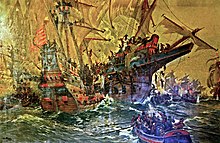Hans Bohrdt
Hans Bohrdt (born February 11, 1857 in Berlin ; † December 19, 1945 there ) was a marine painter .
Life
Hans Bohrdt grew up in Berlin. At the age of 15 he visited the port of Hamburg , which aroused his interest in the sea and shipping . He trained himself as a marine painter . In 1880 he showed works for the first time publicly.
Hans Bohrdt had his greatest sponsor in Kaiser Wilhelm II . He accompanied the monarch several times on his trips to the north and the Mediterranean . Bohrdt had his greatest creative period with the beginning of the fleet building program from the 1890s until the end of the First World War . One of the most famous German propaganda pictures, titled “The Last Man”, whose whereabouts are still unclear, comes from this time .
Around 1900 he designed for the Cologne chocolate producer Ludwig Stollwerck Stollwerck- collecting pictures a . a. for the Stollwerck scrapbook IV and the scrapbook No. 16 “The Great War”. In 1901 he received a small gold medal at the Great Berlin Art Exhibition .

During this time, Bohrdt created several hundred illustrations for books, daily newspapers, reader magazines, postcards and other printed matter such as posters or ship menu cards. With the abdication of Kaiser Wilhelm II and the decline of German naval power and the merchant fleet, Bohrdt's great days were over. He received only a few illustration orders from German shipping companies , such as the North German Lloyd in Bremen or the Hamburg-America Line .
On April 25, 1945, his house in Berlin-Zehlendorf was bombed and completely destroyed. He therefore spent the last few days in a retirement home.
plant
"Probably the most famous German naval picture" comes from Hans Bohrdt. The last man : "A signal guest is said to have stood on the keel of the overturned Leipzig with the war flag in hand and then went down with it. The pose of the sailor is very reminiscent of an icon of 19th century painting, Eugène Delacroix. Freedom leads the people of 1830. "
literature
- Scholl, Lars U .: Hans Bohrdt - marine painter of the emperor , Koehler, Hamburg 1995 ISBN 3-7822-0642-8
Individual evidence
- ↑ Stollwerck's collector's album No. IV, Verlag Gebr. Stollwerck, Berlin, Vienna, New York, 1900.
- ↑ Holger Afflerbach: The art of defeat: A story of surrender. Munich: CH Beck 2013, ISBN 9783406645754 .
Web links
- Literature by and about Hans Bohrdt in the catalog of the German National Library
- The last man (original and parody)
| personal data | |
|---|---|
| SURNAME | Bohrdt, Hans |
| BRIEF DESCRIPTION | German marine painter |
| DATE OF BIRTH | February 11, 1857 |
| PLACE OF BIRTH | Berlin |
| DATE OF DEATH | December 19, 1945 |
| Place of death | Berlin |

